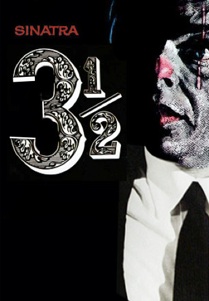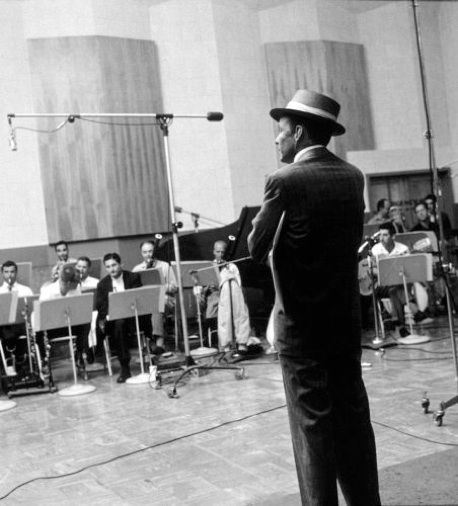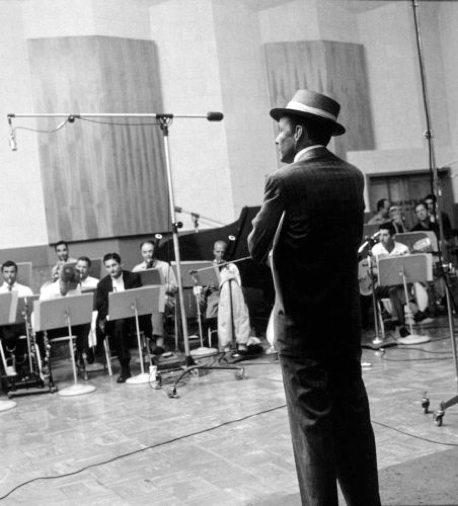Frank Sinatra Sings for Only the Lonely - 1958
Differences between mono and stereo recordings
(WIth apologies to Mr. Fellini.)
Frank Sinatra Sings for Only the Lonely - 1958
Differences between mono and stereo recordings
(WIth apologies to Mr. Fellini.)
Stereo recording efforts started in earnest at the Capitol tower in December of 1956. A few months later, 11/12ths of WHERE ARE YOU was recorded in stereo (one song had technical gremlins in stereo, and was recorded mono-only); A JOLLY CHRISTMAS reverted to mono-only recording; COME FLY WITH ME was recorded in stereo; the aborted NICE ‘n’ EASY-style album project of late 1957 resulted in 7 songs being recorded in stereo (eventually released on THIS IS SINATRA, VOLUME TWO); then came ONLY THE LONELY.
With apologies to my math teacher wife, Jessica:


Definite downer.

This was the last Sinatra album project at Capitol to be recorded separately yet simultaneously in two ways.
For mono:
Probably about ten microphones were used, plus reverb from the famous Capitol echo chambers, all being mixed LIVE during the session to create -- on the spot -- the finished mono mix. Something along these lines:
•Frank’s vocal mic - Neumann [Telefunken] U-47
•Woodwinds - Sony C37a
•Brass - U-47
•Strings - Probably two RCA-44
•Piano/Celeste - RCA-44
•Bass - Altec 639b
•Drums - Altec 21b
•Guitar - RCA 77?
•Small percussion - RCA 44 (if/when needed -- may have shared the brass mic?)
Part of the mono microphone setup is visible in this excellent Sid Avery photo from the May 29, 1958 session for this album:




GREEN appears to be the mono woodwind mic, a then-new Sony C37a. These sessions were unusual for their heavy compliment of woodwind players, so some of the woodwinds are out of view to the left of the frame, and note, too, that the French Horn is lumped in with the woodwinds, as is frequently the case.
BLUE appears to show the stand for the mono piano mic. Note that the lid opens away from the conductor and the other mics, assumedly to give the engineer more control over the balance in the control room
PURPLE appears to show the boom for the mono mic that’s on the harp, most of which is obstructed in the photo by the personage of Mr. Sinatra.
YELLOW appears to be the mono guitar mic stand.
In this photo, Mr. Sinatra appears to be surveying the group from the conductor’s right. The string section is well out of frame to our left, and percussion (mallets and bass drum, perhaps) are out of frame to our right, in front of the brass players, some of whom are visible at the right edge of the photo.
To reiterate: The mono mix was accomplished 100% live. When you listen to the mono mix today, you are hearing the mix as it was created on the fly during the session itself, captured on full-track, 1/4” mono 3M tape, complete with genuine chamber reverb as deemed appropriate at the time. Nothing was “fixed later in the mix.” This WAS the finished mix! (Oh, what a different world we live in today...) Producer Dave Cavanaugh and the mixer assigned to the session (Val Valentin, I think) made adjustments and judgment calls as the session progressed, and when the session was finished, the mix was finished.

For stereo:
When this series of ONLY THE LONELY webpages first appeared in 2010, the mono/stereo part of the discussion included this:


As far as the “you can often hear more details” on the mono versions idea goes, that’s more of a mixed bag than I opined six years ago, as there are many spots where the added detail is actually on the stereo version. As far as the technical notes go, though, things were quite accurate. A few months ago, I visited a Sinatra exhibit at the Grammy Museum in Los Angeles, and they happened to have on display one of the 3-track tape boxes from this album, and it included this sketch (below left), presumably made by Capitol staff mixer Rex Uptegraft, who is credited on the tape box:


Looking again at the photo on the right, above, we can see that Sinatra was standing roughly where the word VOCAL is written in the middle of the photo, and the large stand that is visible to Sinatra’s right in the photo is the “right stereo” mic stand, now highlighted in red. (Martin Melucci first pointed this out several years ago, as I recall.) If the photo included a wider angle of view, we would, presumably, see a “left stereo” mic to Frank’s left, with the two mics essentially dividing the orchestra into thirds: Strings off to the left, woodwinds/French Horns spread across the center area, and rhythm section, brass, and percussion farther to the right.
Note that the photo is from the May 29 session, while the tape box sketch is from the June 25 session, and in both, the piano is clearly positioned to the right, which is exactly where it is heard in the stereo image. However, I suspect that for the May 29 recording of the song ONLY THE LONELY, a larger piano, maybe even a 14’ full concert grand, was brought in, and was positioned at far left. I suspect this because on just that one song, the piano is played in a somewhat (pardon the cliche) Tchaikovskian manner, perhaps with a more “classical” sound being desired, and is clearly positioned at far left, which is unique for this album. (More about the positioning of the piano later.)
Additional details about the tape box can be found online, starting here, if interested.
Some clips illustrating the effects of the differing mono and stereo recording styles can be heard here: SamplesMonoThenStereo.mp3
